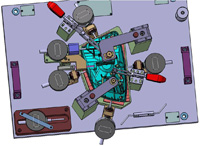Rear-view mirror Housing
Rear-view mirror housings can either be controlled as single parts, or as two separated parts (housing bracket and housing), depending on the design of the rear-view mirror. The critical aspects usually controlled in this type of part are: the outline deformation, the fitting with the mirror assembly components, and the location and/or diameter of the part fixation holes. These features can be controlled either by Go/No Go controls, or by dial indicators.
Our checking fixtures are produced in aluminium, the components submitted to wear-and-tear are produced in steel. Tolerances for RPS (fixation points) and dial indicator points: ±0.05mm. Tolerances for simulation blocks: ±0.1mm.
Minimum documentation: dimensional report of your checking fixture, 2D assembly drawing, assembly CAD. Optional documentation: R&R report, user manual, stabilization certificate.
Depending on the requirements of the customer, the number of dial indicator control points on housing checking fixtures can be quite high. In that case, automating the measurement process in order to improve traceability, prevent measurement faults and get a good follow-up of the measurement is crucial; solutions like CAPTOR-S, and its complement CAPTOR-C can thus easily be justified for the time and cost they enable to save.
Control of the fixation holes location
Complete checking fixture

